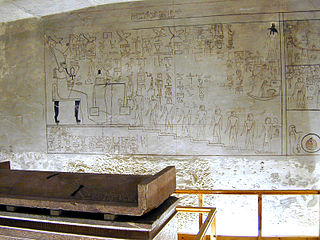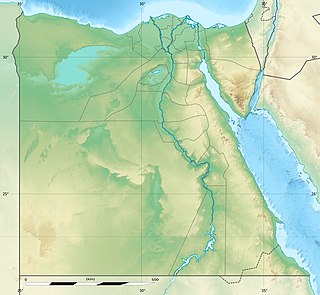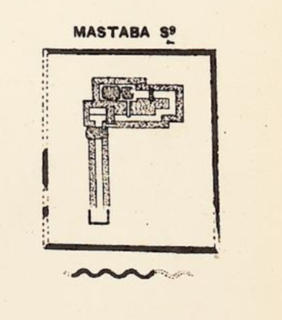
Abydos is one of the oldest cities of ancient Egypt, and also of the eighth nome in Upper Egypt. It is located about 11 kilometres west of the Nile at latitude 26° 10' N, near the modern Egyptian towns of El Araba El Madfuna and El Balyana. In the ancient Egyptian language, the city was called Abdju. The English name Abydos comes from the Greek Ἄβυδος, a name borrowed by Greek geographers from the unrelated city of Abydos on the Hellespont.

Saqqara, also spelled Sakkara or Saccara in English, is an Egyptian village in Giza Governorate, that's world-widely known for its vast, ancient burial ground of Egyptians kings and royals, serving as the necropolis for the ancient Egyptian capital, Memphis. Saqqara contains numerous pyramids, including the world-famous Step pyramid of Djoser, sometimes referred to as the Step Tomb, and a number of mastaba tombs. Located some 30 km (19 mi) south of modern-day Cairo, Saqqara covers an area of around 7 by 1.5 km.

KV55 is a tomb in the Valley of the Kings in Egypt. It was discovered by Edward R. Ayrton in 1907 while he was working in the Valley for Theodore M. Davis. It has long been speculated, as well as much-disputed, that the body found in this tomb was that of the famous king, Akhenaten, who moved the capital to Akhetaten. The results of genetic and other scientific tests published in February 2010 have confirmed that the person buried there was both the son of Amenhotep III as well as the father of Tutankhamun. Furthermore, the study established that the age of this person at the time of his death was consistent with that of Akhenaten, thereby making it almost certain that it is Akhenaten's body. However, a growing body of work soon began to appear to dispute the assessment of the age of the mummy and the identification of KV55 as Akhenaten.

The Middle Kingdom of Egypt is the period in the history of ancient Egypt following a period of political division known as the First Intermediate Period. The Middle Kingdom lasted from approximately 2040 to 1782 BC, stretching from the reunification of Egypt under the reign of Mentuhotep II in the Eleventh Dynasty to the end of the Twelfth Dynasty. The kings of the Eleventh Dynasty ruled from Thebes and the kings of the Twelfth Dynasty ruled from el-Lisht.

Merneith was a consort and a regent of Ancient Egypt during the First Dynasty. She may have been a ruler of Egypt in her own right, based on several official records. If this was the case and the earlier royal wife Neithhotep never ruled as an independent regent, Merneith may have been the first female pharaoh and the earliest queen regnant in recorded history. Her rule occurred around 2950 BC for an undetermined period. Merneith’s name means "Beloved by Neith" and her stele contains symbols of that ancient Egyptian deity. She may have been Djer's daughter and was probably Djet's senior royal wife. The former meant that she would have been the great-granddaughter of unified Egypt's first pharaoh, Narmer. She was also the mother of Den, her successor.

Khasekhemre Neferhotep I was an Egyptian pharaoh of the mid Thirteenth Dynasty ruling in the second half of the 18th century BC during a time referred to as the late Middle Kingdom or early Second Intermediate Period, depending on the scholar. One of the best attested rulers of the 13th Dynasty, Neferhotep I reigned for 11 years.

Khaneferre Sobekhotep IV was one of the more powerful Egyptian kings of the 13th Dynasty, who reigned at least eight years. His brothers, Neferhotep I and Sihathor, were his predecessors on the throne, the latter having only ruled as coregent for a few months.

Sekhemre Khutawy Sobekhotep was an Egyptian pharaoh of the 13th Dynasty during the Second Intermediate Period, who reigned for at least three years c. 1800 BC. His chronological position is much debated, Sekhemre Khutawy Sobekhotep being either the founder of the dynasty, in which case he is called Sobekhotep I, or its twentieth ruler, in which case he is called Sobekhotep II. In his 1997 study of the Second Intermediate Period, the Egyptologist Kim Ryholt makes a strong case for Sekhemre Khutawy Sobekhotep as the founder of the dynasty, a hypothesis that is now dominant in Egyptology.

Tomb KV57 is the royal tomb of Horemheb, the last pharaoh of the Eighteenth Dynasty and is located in the Valley of the Kings, Egypt.

Nubkheperre Intef was an Egyptian king of the Seventeenth Dynasty of Egypt at Thebes during the Second Intermediate Period, when Egypt was divided by rival dynasties including the Hyksos in Lower Egypt. He is known to be the brother of Sekhemre-Wepmaat Intef—and this king's immediate successor—since he donated Louvre Coffin E3019 for this king's burial which bears an inscription that it was donated for king Sekhemre Wepmaat Intef "as that which his brother, king Antefgives", notes Kim Ryholt. As the German scholar Thomas Schneider writes in the 2006 book Ancient Egyptian Chronology :

The Valley of the Kings, also known as the Valley of the Gates of the Kings, is a valley in Egypt where, for a period of nearly 500 years from the 16th to 11th century BC, rock-cut tombs were excavated for the pharaohs and powerful nobles of the New Kingdom.

Neferuptah or Ptahneferu was a daughter of the Egyptian king Amenemhat III of the 12th Dynasty. Her sister was the Pharaoh Sobekneferu.
Josef William Wegner is an American Egyptologist, archaeologist and associate professor in Egyptology at the department of Near Eastern Languages and Civilizations of the University of Pennsylvania, where he obtained his Ph.D. degree in Egyptology. His father is the astrophysicist, Gary A. Wegner.

Menwadjre Sihathor was an ephemeral ruler of the 13th Dynasty during the late Middle Kingdom. Sihathor may never have enjoyed an independent reign, possibly only ruling for a few months as a coregent with his brother Neferhotep I. According to Egyptologist Kim Ryholt, Sihathor died in 1733 BC while Detlef Franke dates his short reign to 1694 BC. His tomb is likely to be the unfinished one located between the tombs of his brothers S9 and S10, in Abydos.

Woseribre Senebkay was an ancient Egyptian pharaoh during the Second Intermediate Period. The discovery of his tomb in January 2014 supports the existence of an independent Abydos Dynasty, contemporary with the Fifteenth and Sixteenth Dynasties during the Second Intermediate Period. He might also appear in the Turin Canon, where there appear two kings with the throne name "Weser... re". A further possible object with his name is a magical wand bearing the name Sebkay. The wand was found at Abydos but could refer to one or possibly two kings of the earlier 13th Dynasty. The existence of the so-called Abydos Dynasty was first proposed by Detlef Franke and later further developed by Kim Ryholt in 1997.
The Abydos Dynasty is hypothesized to have been a short-lived local dynasty ruling over parts of Middle and Upper Egypt during the Second Intermediate Period in Ancient Egypt. The Abydos Dynasty would have been contemporaneous with the Fifteenth and Sixteenth Dynasties, from approximately 1650 to 1600 BC. It would have been based in or around Abydos and its royal necropolis might have been located at the foot of the Mountain of Anubis, a hill resembling a pyramid in the Abydene desert, close to a rock-cut tomb built for pharaoh Senusret III.

Haankhef was the father of the ancient Egyptian kings Neferhotep I, Sihathor, and Sobekhotep IV, who successively ruled Egypt during the second half of the 18th century BC as kings of the 13th Dynasty.
The Southern South Saqqara Pyramid is an ancient Egyptian royal tomb which was built during the 13th Dynasty in South Saqqara, and is renowned for having the most elaborate hypogeum since the late 12th Dynasty pyramids. The building remains unfinished and its owner is still uncertain as no unambiguous evidence has been found to settle the issue. In 2008, the Egyptologist Christoffer Theis proposed that the pyramid was built for king Djehuti, based on a inscription discovered nearby by Gustave Jéquier.

Wah-Sut is a town located south of Abydos in Middle Egypt. The name of the town indicates that it was originally built as an outlying part of Abydos, set up by the Egyptian state as housing for the people working in and around the funerary complex of pharaoh Senusret III of the Twelfth Dynasty, at the peak of the Middle Kingdom.

S 9 is the modern name given to a monumental ancient Egyptian tomb complex at Abydos in Egypt. The tomb is most likely royal and dates to the mid-13th Dynasty, during the late Middle Kingdom. Finds from the area of the tomb indicate that S9 suffered extensive, state-sanctioned stone and grave robbing during the Second Intermediate Period, only a few decades after its construction, as well as during the later Roman and Coptic periods. Although no direct evidence was found to determine the tomb owner, strong indirect evidence suggest that the neighbouring and slightly smaller tomb S10 belongs to pharaoh Sobekhotep IV. Consequently, S9 has been tentatively attributed by the Egyptologist Josef W. Wegner to Sobekhotep IV's predecessor and brother, Neferhotep I . According to Wegner, the tomb might originally have been capped by a pyramid.




















